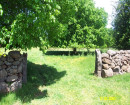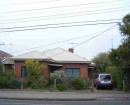Rokewood Precinct
ROKEWOOD, Golden Plains Shire
-
Add to tour
You must log in to do that.
-
Share
-
Shortlist place
You must log in to do that.
- Download report



Statement of Significance
What is Significant?
The township of Rokewood is located on the Geelong to Skipton Road approximately 70 kms north-west of Geelong. It is nestled within a curve of the Kuruc-a-ruc Creek and is situated within a broader agricultural landscape. The township was gazetted in 1852. Its allotments are generally aligned north-south to east-west, with nine regular sections to the south of Ferrars Street and three irregular sections to the north. Rokewood developed during the gold-rush years as a civic and commercial centre, servicing both mining communities as well as surrounding pastoral properties. It became an important stop on the colonial trade routes that linked the port of Geelong to the Ballarat goldfields and further west into the interior of the Western District. It was also important as a crossroads for people moving north-south. There are records of gold mining taking place in the Rokewood area as early as the 1850s, with the Mt Misery-Rokewood goldfields operating by 1852. In 1856, successful mining inspired a 'huge influx of diggers to what was known as Rokewood Rush', which continued into the mid nineteen century. By 1865, the population of 'Rokewood and the diggings in the vicinity' was about 950 persons. The township held a court of petty sessions, a post and money order office, two schools, and two hotels being the Rokewood and the Victoria. A permanent constable was stationed at Rokewood from 1857, followed by the construction of a police station in 1859. The Rokewood Presbyterian Church dominates the township. It was designed by Alexander Davidson in 1866 who, for a time, operated his architectural practice from Rokewood. It was his first major commission and the construction of its tower, the last in 1905. With his new partner, George Henderson he went on to become one of Geelong's most innovative, influential and prolific architects. The church's construction was a clear statement by the local squattocracy who were staunchly Presbyterian. The official opening of the church took place on Thursday the 23rd of August 1866.
A second gold discovery and subsequent increase in population was experienced in the late 1880s. During the post-gold rush years, the township continued to grow as the center of a prosperous pastoral and agricultural district. The township has been associated with a number of early pioneer families, who settled on large pastoral runs located in the district in the late 1830s and early 1840s, and beyond. These properties include 'Commeralghip', 'Dereel', 'Glenfine', 'Wurrook', and 'Kuruc-a-ruc' The subdivision of pastoral properties for the WW2 Soldier Settlement Scheme saw another significant increase in population and a boost to all sorts of social aspects of the town's development during the 1950s and 1960s. The war memorial and the Rokewood Memorial Hall erected in 1959 commemorates the contribution of members of Rokewood district in each of the Great Wars.
The township of Rokewood remains substantially intact and the surviving buildings and infrastructure from a range of periods retain a medium to high degree of integrity. Key public and civic buildings, open public space and surviving examples of commercial and residential development provide a clear sense of past and present settlement.
How is it significant?
The township of Rokewood is of historical, architectural and social significance for the Golden Plains Shire.
Why is it significant?
The township of Rokewood is of historical significance as one of the many small settlements in the Shire established to support nearby gold mining and agricultural industries during the 1850s and again in the 1880s. It has direct associations with several important Scottish pioneers. It is of architectural significance for its range of commercial, residential and public buildings dating from the nineteenth century, the most important being the Rokewood Presbyterian Church and the surviving row of commercial premises with attached residences on the southern side of Ferrars Street. The town is of social significance as the focus of community activity and as a representation of the inter-relationship between pastoral, mining and agricultural industries.
-
-
Rokewood Precinct - Historical Australian Themes
Australian Historic Themes
The Australian Heritage Commission devised the Australian Historic Themes in 2001. The following themes have influenced the historical development of the Rokewood Precinct.
2. Peopling Australia
2.2 Adapting to diverse environments
2.5 Promoting settlement
3 Developing Local, Regional And National Economies
3.3 Surveying the continent
3.3.3 Prospecting for precious metals
3.3.4 Looking for land with agricultural potential
3.3.5 Laying out boundaries
3.4 Utilising natural resources
3.4.3 Mining
3.5 Developing primary production
3.5.1 Grazing stock
3.5.2 Breeding animals
3.5.3 Developing agricultural industries
3.6 Recruiting labour
3.7 Establishing communications
3.7.1 Establishing postal services
3.8 Moving goods and people
3.8.5 Moving goods and people on land
3.8.6 Building and maintaining railways
3.8.7 Building and maintaining roads
3.12 Feeding people
3.12.5 Retailing foods and beverages
3.26 Providing health services
3.26.2 Providing hospital services
4 Building Settlements Towns And Cities
4.1 Planning urban settlements
4.1.1 Selecting township sites
4.2 Supplying urban services (power, transport, fire prevention, roads, water, light and sewerage)
4.3 Developing institutions
4.5 Making settlements to serve rural Australia
5 Working
5.1 Working in harsh conditions
5.1.2 Coping with dangerous jobs and workplaces
5.6 Working in the home
5.8 Working on the land
6 Educating
6.1 Forming associations, libraries and institutes for self-education
6.2 Establishing schools
7 Governing
7.6 Administering Australia
7.6.1 Developing local government authorities
7.6.3 Policing Australia
8 Developing Australia's Cultural Life
8.6 Worshipping
8.6.1 Worshipping together
8.6.2 Maintaining religious traditions and ceremonies
8.6.4 Making places for worship
8.5 Forming associations
8.8 Remembering the fallen
8.12 Living in and around Australian homes
8.14 Living in the country and rural settlements
Rokewood Precinct - Physical Description 1
The township of Rokewood is located on the Geelong to Skipton Road approximately 70 kms north-west of Geelong. It is nestled in a curve of the Kuruc-a-ruc Creek and is situated within a broader agricultural landscape. The township is generally aligned north-south to east-west and is divided by Ferrars Street, the main street. It is laid out in a conventional grid, with nine regular sections to the south of Ferrars Street and three irregular sections to the north. Approaching from the west, the Rokewood Skipton Road intersects the Colac Ballarat Road before crossing the Kuruc-a-ruc Creek.
The Rokewood Heritage Precinct is located on either side of Ferrars Street, bound by the Rokewood - Meadows Road to the west and Gibb Street to the east. The Rokewood Hotel (75 Ferrars Street) is situated adjacent to the crossing of the Kuruc-a-ruc Creek and signals the beginning of a row of important shops located on the southern side of Ferrars Street. These commercial premises have little or no set back from the street and are situated on large residential allotments. They include the former timber shop and private residence (69 Ferrars Street), Daly's Store (67 Ferrars Street) which operates as a post office and general store and comprises an early stone detached kitchen at the rear, with a steep hipped roof and two Phoenix canariensis (Canary Island Palms) and a Cupressus sempervirens (Italian Cypress) in the rear year. It has elaborate, but now faded, signage in the upper sections of the original windows. The former pair of shops, now a private residence (65 Ferrars Street) features a twin pitched shallow hipped roof, surviving entrance doors, multi pane casement windows of twelve pane and nine panes respectively and a skillion verandah. The twin gabled timber clad residence (61 Ferrars Street) has an awning verandah, large plate glass windows and evidence of a former entrance addressing the street. The cream brick milk bar (57 Ferrars Street) dating from the Interwar period, has had the facade rebuilt to accommodate large plate glass windows. The 1950s former Bank building (55 Ferrars Street) and attached manager's residence is now used as a Healthcare Centre. It is aligned at an angle to the street, with large plate glass windows and a skillion roof.
A wide median strip divides the shops on the southern side of Ferrars Street from the civic and public buildings located on north side of the street. A concrete war memorial incorporating a flag pole and plaques commemorating the districts fallen soldiers is located adjacent to a cream brick public toilet. The grass verge also features public artworks, historic agricultural implements and a BBQ facility.
Buildings located on the northern side of Ferrars Street are accessed by a service road. These include the Rokewood Memorial Hall (66 Ferrars Streett), the Allan Bell Hall (60 Ferrars Street) and the Presbyterian Church (60 Ferrars Street). The church is the most dominant building in the township. It is a Latin cross in plan, built of bluestone with sandstone dressings and has a slate roof and a sandstone spire. There is a vestry in the north-east re-entrant angle. The Alan Bell Hall is a simple timber re-located structure, situated at the rear.
Rokewood Precinct - Integrity
The township of Rokewood remains substantially intact and the surviving buildings and infrastructure from a range of periods retain a medium to high degree of integrity. Key public and civic buildings, open public space and surviving examples of commercial and residential development provide a clear sense of past and present settlement.
Rokewood Precinct - Physical Description 2
Contributory elements located in the proposed Rokewood Heritage Precinct:
Rokewood Memorial Hall, 66 Ferrars Street Rokewood
War Memorial, Ferrars Street Rokewood
Hesse Rural Health, 55 Ferrars Street Rokewood
Brick Shop, Ferrars Street Rokewood
House (former shop), 61 Ferrars Street Rokewood
Pair of shops, 65 Ferrars Street Rokewood
Daly's Store and residence, 67 Ferrars Street Rokewood
Shop and residence, 69 Ferrars Street Rokewood
Rokewood Hotel, 75 Ferrars Street Rokewood
Heritage Study and Grading
Golden Plains - Golden Plains Shire Heritage Study Phase 2
Author: Heritage Matters P/L
Year: 2009
Grading: Local
-
-
-
-
-
TRY AGAIN CO.
 Victorian Heritage Inventory
Victorian Heritage Inventory -
UNNAMED MINES
 Victorian Heritage Inventory
Victorian Heritage Inventory -
CARR & STANBROOK
 Victorian Heritage Inventory
Victorian Heritage Inventory
-
-






